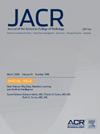应用社会生态模型解决放射学女性的招聘、晋升和领导力发展。
IF 5.1
3区 医学
Q1 RADIOLOGY, NUCLEAR MEDICINE & MEDICAL IMAGING
引用次数: 0
摘要
女性占医学院毕业生的近50%,在放射科实习医师中一直占25%左右。来自不同背景的放射科医生的招聘、晋升和领导力发展对该领域的持续发展至关重要。尽管主要的放射学会和期刊在所有实践层面都支持这一事业,但改善该领域多样性的努力仍然有限。社会生态模型已被用于通过评估个人与其环境之间的相互作用来解决卫生保健方面的挑战。在这篇文章中,我们以先前的文献为基础,描述了女性在招聘、晋升和领导力发展方面面临的挑战,通过应用社会生态模型来系统地理解和解决阻碍合格女性在放射学领域发展的障碍。我们评估了女性在招聘、晋升和领导力发展方面面临的挑战,并提出了基于证据的解决方案,旨在解决女性在该领域发展的障碍。本文章由计算机程序翻译,如有差异,请以英文原文为准。
Application of the Socio-Ecological Model to Address Recruitment, Promotion, and Leadership Development of Women in Radiology
Women, who represent nearly 50% of medical school graduates, consistently comprise approximately 25% of radiology residency spots. Recruitment, promotion, and leadership development of radiologists from diverse backgrounds is important for continued growth of the field. Despite major radiological societies and journals championing this cause across all practice levels, efforts to improve diversity in the field have been limited. The socio-ecological model has been used to address challenges in health care by evaluating the interplay between individuals and their environment. In this article, we build on prior literature describing challenges faced by women in recruitment, promotion, and leadership development by applying the socio-ecological model to systematically understand and address barriers to the advancement of qualified women in radiology. We evaluate challenges women face in terms of recruitment, promotion, and leadership development at each level of the socio-ecological model and propose evidence-based solutions aimed at addressing barriers to the advancement of women in the field.
求助全文
通过发布文献求助,成功后即可免费获取论文全文。
去求助
来源期刊

Journal of the American College of Radiology
RADIOLOGY, NUCLEAR MEDICINE & MEDICAL IMAGING-
CiteScore
6.30
自引率
8.90%
发文量
312
审稿时长
34 days
期刊介绍:
The official journal of the American College of Radiology, JACR informs its readers of timely, pertinent, and important topics affecting the practice of diagnostic radiologists, interventional radiologists, medical physicists, and radiation oncologists. In so doing, JACR improves their practices and helps optimize their role in the health care system. By providing a forum for informative, well-written articles on health policy, clinical practice, practice management, data science, and education, JACR engages readers in a dialogue that ultimately benefits patient care.
 求助内容:
求助内容: 应助结果提醒方式:
应助结果提醒方式:


